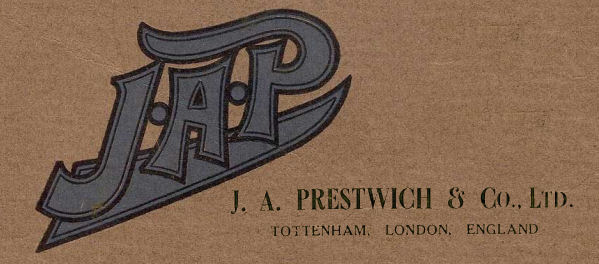


The new 2 ¾ h.p. J.A.P. engine of 292 c.c. (R.) Chain drive for magneto replaces the gear drive of the earlier models.

Timing gear of the new J.A.P. lightweight engine, showing integral magneto platform and timing case cover.
Increased Radiating Surface — Chain-driven Magneto — Improved Valve Lifter.
AFTER years of war and munition work it was distinctly refreshing to be able to go through Messrs. J. A. Prestwich's works at Northumberland Park, Tottenham, London, N.W.17, and see the old familiar parts on practically every machine tool, showing great activity in the factory and a rapid production of J. A. P. engines.
The little 2 ½ h.p. has progressed considerably in design, so much so that certain modifications in the cylinder, such as the increased size of the radiating fins, have resulted in the engine being more aptly rated in the future at 2 ¾ h.p. Its bore and stroke are 70 mm. x 76 mm., and the magneto, which was formerly gear-driven, is now chain-driven, the cover of the chain casing serving as timing gear cover and forming also a platform for the magneto.
Exhaust Valve Lifter.
The engine has been improved further by the fitting of a simple and ingenious internal exhaust lift, and the provision of two bearings for the large timing wheel spindle, one in the inside of the timing gear case and the other in the cover. The boss of the latter serves as a bearing for the lever, of which the cam forms a part, actuating against the heel of the exhaust rocker, thus serving to raise the exhaust valve.
In our illustration the ingenious Bowden wire fitment and the internal exhaust cam lifter are clearly shown. The crank case of this engine is now entirely oil-tight, and on referring to one of the photographs it will be seen that a special oil ring is cast on the pulley side of the crank case, so as to catch any excess of oil which might leak through and drain it neatly away without soiling the crank case. Some improvement has also been effected in the silencer, which is now of ample dimensions and of pressed steel. The valves are large, and the tappets adjustable. Altogether, the new 2 ¾ h.p. J. A. P. is a thoroughly clean job, and highly suitable for light and medium weight motor cycles.
As this engine is one of the few two-strokes under 300 c.c. capacity on the market at the present time, undoubtedly it will be in great demand from the many smaller makers who specialise in solo motor cycles. Already we have dealt with several such machines, the demand for which considerably exceeds the supply.
The Motor Cycle March 27th, 1919, page 310